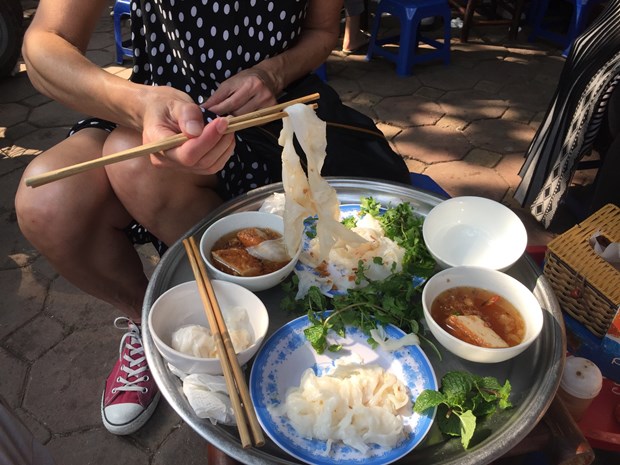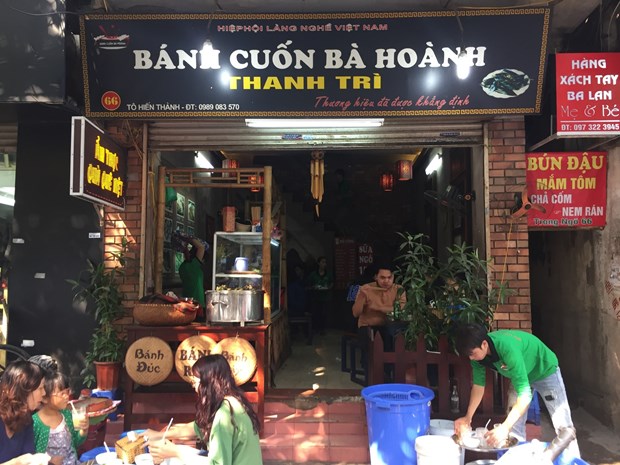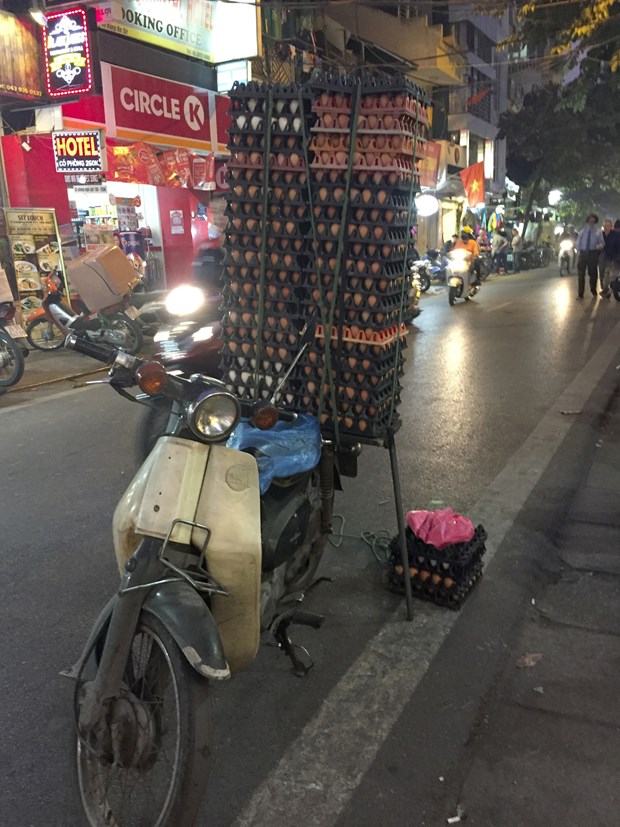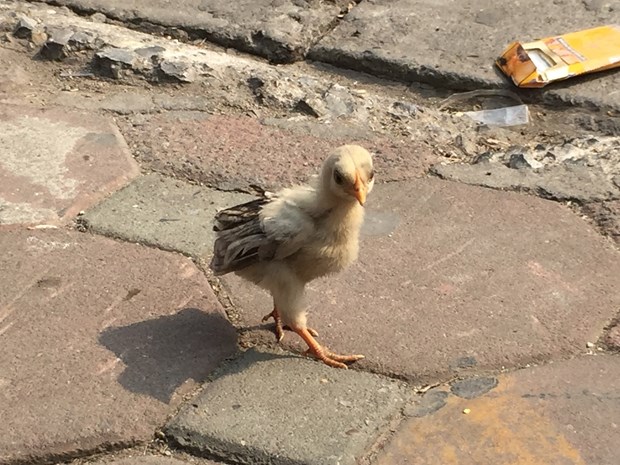Seattle’s known for its Vietnamese food. Bethany Jean Clement went to Vietnam, and here she shares some of her stories from one of the best places to eat on Earth.
If
you’re new to Hanoi, you have to learn how to cross the street. The traffic is
a miasma of motor scooters, taxis, bicycles (some laden with an improbable
stack of crates of eggs, or a clinking cloud of ceramic cups, or a big bushel
of flowers), short buses disgorging confused tourists, pedicabs with tasseled roofs,
regular cars, and the occasional leviathan of a city bus rumbling through,
parting the sea of it all. As Tan Vinh put it, traffic signals, when they’re
there, are more of a suggestion.

A fruit basket on Phu Quoc Island is a thing of beauty.(Bethany Jean Clement / The Seattle Times)
When
you need to learn to cross the street again, it’s nice to have someone to hold
your hand; Tan, my husband and I all work at The Seattle Times together, and we
are lucky to count him as a friend as well as a colleague. Tan’s from Vietnam,
and he kindly let us overlap with his trip back there at the end of last year,
orienting us in innumerable invaluable ways upon our arrival.
In
Hanoi, Tan told us, the flow of traffic, while appearing chaotic, has its own
amorphous order. The secret for pedestrians, he said, is to wait for a
semblance of a lull, then set out at a moderate pace, and just walk,
unflinchingly, across. Steadiness, he said, is the key; don’t stop, and, for
god’s sake, don’t start running — let it all absorb you and flow around you.
This was nerve-wracking, then amazing, then occasionally nerve-wracking again,
like Hanoi itself.

On a Hanoi sidewalk, eating banh uot: translucent sheets of gossamer crepe-noodles, served with broth for dipping and blocks of sausage. (Bethany Jean Clement / The Seattle Times)
If
you’ve seen Anthony Bourdain on the topic (or read the recent New Yorker
profile), you know that Hanoi’s all about the life of the street. (We spent a
couple nights at the posh Metropole Hotel, where Bourdain stayed; like all
lodgings in Vietnam, it’s a bargain for its class, but it wasn’t that special,
and we were never there. The over-the-top Apricot Hotel is a better value.) Tan
took us directly to his new favorite spot in an alley for bún chả — fat patties
of pork sausage cooked on a hibachi-style charcoal grill, served with rice
noodles, a salty-tart-sweet broth for dipping, and a mountain of fresh lettuces
and herbs, eaten while sitting on stubby little plastic stools and costing a
few dollars per person. Then he took us to Hanoi’s famous intersection of
beer-drinking, where the sidewalk cafe-bars take over the street and a
jampacked party starts early every evening, with vendors selling nuts,
deliciously styrofoam-y shrimp-flavored chips, balloons in giant bouquets, and
more.

Banh Cuon Ba Hoanh, a local favorite for banh cuon in Hanoi. (Bethany Jean Clement / The Seattle Times)
Of
course, we ate everybody’s favorite, phở. But Tan knows I love bánh cuốn: tender rice-flour crepes,
made by spreading batter over a piece of cloth stretched over a steamer.
They’re sprinkled with bits of pork and mushroom, then rolled up and topped
with a bologna-like (but better!) sausage, plus fried shallot for crunch and
fresh herbs, with nước chấm (fish sauce) for dipping. All the different tastes
together make every bite interesting and refreshing, and the best bánh cuốn’s texture is
slippery-delicate, almost airy. (If that sounds impossibly odd, I dare you to
go try it: Seattle’s Ba Bar makes the city’s best version, every day in South
Lake Union, weekends only in the Central District.) Tan took us to one no-name
streetside place, then gave us the address of another he’d already checked out
and approved called Bánh Cuốn Bà Hoành.
(“A local favorite,” his answer to my where’s-that-place-again email said,
“they don’t speak English, but you can just order two.”)

Banh Cuon Ba Hoanh, a local favorite for banh cuon in Hanoi. (Bethany Jean Clement / The Seattle Times)
We
walked across a sizable part of the city to get there — why not? — encountering
a small chicken who seemed to belong to a busy intersection’s corner store,
then stopping at a big open-air bia-hơi beer hall for refreshment. When we
finally got there, what we got by holding up two fingers wasn’t bánh cuốn but its cousin, bánh ướt:
translucent sheets of the same gossamer crepe-noodles draped in a heap, ever so
slightly sour-tasting, served with a sweetish, warm broth for dipping and
blocks of sausage, plus a super-spicy chili oil and super-sharp vinegar to add
in. The table was on the sidewalk, and the soundtrack was the traffic; the
price mysteriously changed from about $4 each, as the first person said, to
about $2.50 when we actually got the bill. It was fantastic.
Hue
We
left Tan, thanking him profusely, and took a train south. It was the rainy
season in Hue, in Vietnam’s midsection, with the downpour only occasionally
relenting to a drizzle. We sprang for some of the city’s fanciest lodgings, the
Hotel Saigon Morin, built in 1901, for about $90 a night. Charlie Chaplin
honeymooned here; our palatial room had hardwood floors, a balcony, and
wingback chairs perfect for sitting in front of the open balcony doors watching
the rain. The hotel was largely deserted — apparently, most people have more
sense than to visit Hue in December — so we had the bar’s evening showings of
Charlie Chaplin movies to ourselves. Same with the covered outdoor billiards
table, where a bat flew in midgame and dropped an unidentifiable piece of fruit
on the floor, while the nighttime deluge kept the nearby swimming pool filled
to the rim.

This cute chicken lived at a corner store at a busy Hanoi intersection. (Bethany Jean Clement / The Seattle Times)
For
a dice-roll dinner, we tried the place closest to the hotel that was
highest-rated on TripAdvisor: Ancient Town Restaurant. On the bank of the
Perfume River, it was a small, elegant dark-lacquered-wood structure — open-air
but prettily screened from any blowing-sideways precipitation, lit by lanterns
and candles. We ate the city’s limey, lemongrassy, spicy soup, bún bò Huế, just
right for a rainy night; then bánh nậm, like tamales, wrapped in banana leaf, but
made with marvelously melty-soft rice flour instead of masa, served with the
region’s extra-pungent, sinus-clearing nước chấm.
For
French food in Hue, a guidebook recommended Les Jardins De La Carambole, where
we were led up a wrought-iron-bannistered stairway to the second floor of a
classic colonial villa, high-ceilinged and tile-floored. The menu came tied
with a red ribbon; we ordered a bottle of rosé. The most boring thing possible
— chicken in white wine cream sauce — was wonderful, with whole cloves of
garlic, accompanied by a torpedo-shaped lobe of the world’s richest, creamiest
mashed potato. A long table nearby filled up with a group of tourists; they
proved to be French, so they never guffawed or shouted, just seemed to enjoy
their food and each other’s company immensely.
Hue,
one day, also gave us the gift of the best worst meal ever. After hours of
walking through the palaces and plazas and temples of its labyrinthine,
overwhelming walled imperial city, it was not possible to stay dry. Even a local-style
poncho — like a giant shower curtain with a hood — was unequal to the rain, and
the day wasn’t quite warm enough to stave off a chill after your sneakers
soaked through. We made it to the immense formal gardens, with paths and ponds
and bird-shaped topiary, slightly overgrown; there was no one else in sight.
Then, just as low blood sugar and wet feet combined forces for crankiness, a
small, carved-wood pavilion appeared. In a wordless welcome, the proprietors
helped us wrestle off our rain gear, and within minutes we had hot cups of
way-too-sweet lemon tea. The noodles served there were instant ones, but eating
them, looking out at the rain soaking the formal foliage as far as the eye
could see, we could’ve been royalty.

Ceramics in transit on the street in Hanoi. (Bethany Jean Clement / The Seattle Times)
Phu Quoc Island
After
the rain, we went south to Phu Quoc Island, closer to Cambodia than Vietnam but
still part of the latter, famous for its high-quality peppercorns. A special on
Hotels.com found us washed up with a bunch of good-looking, casually wealthy,
mostly European tourists at a small, rustic-chic eco-resort called Mango Bay.
Here, the sand was so clean and fine that it obligingly squeaked underfoot;
even the bumblebees were better — huge, silent, super-fuzzy, striped in
striking orange and black. When cicadas dared to make the sound of fire alarms
screaming, the handsome Swiss manager assured, “They’ll die soon.”
The
resort’s included breakfasts, taken on a veranda directly on the cerulean water
of the Gulf of Thailand, were absurdly great. They made their own French pastries,
and made them very well; same with Vietnamese-style yogurt, which has a
limey-tartness to it, smooth and rich but light, not thick. Each morning’s
fruit basket was a thing of beauty: hot-pink-shelled dragonfruit, its mild
white flesh dotted with crispy little black seeds; passion fruit, with its
saffron-colored, gelatinous-then-crunchy insides like nature’s Sour Patch Kids;
jelly-sweet fresh lychee; mango, of course.
We
asked the handsome Swiss manager if he’d recommend a restaurant we could walk
to, departing the compound for a place he said didn’t used to have a name, but
was now called Noname BBQ. Here, you choose from piles of raw seafood and
vegetables on tables by the side of the road, then have a seat and a
miraculously cold Saigon beer in a concrete courtyard while your food gets its
turn on the grill. A dog wandered around, not bothering to beg. Our tiny
plastic table was overloaded with eggplant turned silky-hot and a whole snapper
with a spicy mango sauce when the electricity suddenly went off, extinguishing
the bare bulbs overhead and the loud pop music from the bar next door. Everyone
eating gave a mild cheer, the grill guy continued by the light of his
cellphone, and a little girl in pajamas helped distribute red candles, which
got affixed to the tables with their own wax. And everything, if possible, was
even better.
By Bethany Jean Clement
Seattle Times staff
columnist